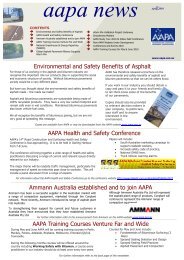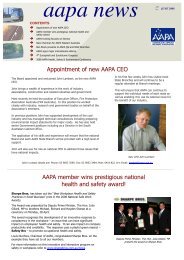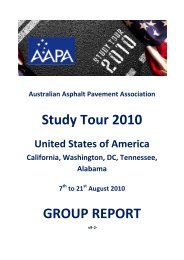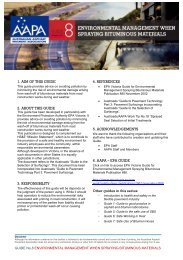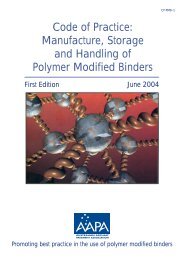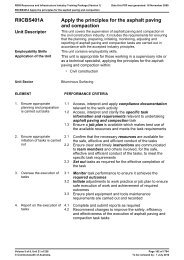Asphalt Review - Volume 29 Number 2 (June / July 2010)
Asphalt Review - Volume 29 Number 2 (June / July 2010)
Asphalt Review - Volume 29 Number 2 (June / July 2010)
Create successful ePaper yourself
Turn your PDF publications into a flip-book with our unique Google optimized e-Paper software.
ASPHALT REVIEW<br />
See Table 1. for a comparison of<br />
typical temperatures (degrees C)<br />
measured on a trial carried out on 10<br />
March <strong>2010</strong> in Queen Street for the<br />
Parramatta Council.<br />
More benefits with LoCarb<br />
“LoCarb is a win-win for the environment<br />
and from a sustainability perspective,<br />
with a simultaneous reduction in energy<br />
consumed and emissions generated<br />
during the manufacturing process,” says<br />
Boral’s <strong>Asphalt</strong> Technology Manager,<br />
Trevor Distin.<br />
There is also a saving in the amount<br />
of non-renewable raw materials such<br />
as bitumen and aggregates required to<br />
produce asphalt.<br />
The benefits of using LoCarb asphalt<br />
extend further than those already<br />
mentioned.<br />
“The lowering of application<br />
temperatures means that we are now<br />
able to achieve the same, if not better,<br />
compaction and production rates in the<br />
field. This is because the mix compacts<br />
more uniformly and allows us to open it<br />
to traffic sooner,” Mr Distin says.<br />
“On a recent job the temperature was<br />
measured behind the paver for both a<br />
traditional hot mix and LoCarb asphalt<br />
using an infrared thermal imaging<br />
camera. The temperature readings<br />
recorded across the mat supported our<br />
belief that there was far less variation<br />
for LoCarb than hot mixed asphalt<br />
and this is a key factor to achieving a<br />
uniform density in the mat after final<br />
compaction.”<br />
The temperature profile measured by<br />
Thermovision Services across the mat<br />
behind the paver for HMA vs LoCarb.<br />
There is also a significant reduction<br />
in fumes and odours generated because<br />
LoCarb is produced and placed<br />
below the fuming temperature of<br />
bitumen. Bitumen typically fumes at a<br />
temperature around 135 degrees C and<br />
the rate of fuming doubles with every<br />
10 degree increase in temperature.<br />
This helps improve the quality of air<br />
for people living within the vicinity of<br />
an asphalt plant and for the asphalt<br />
workers placing LoCarb.<br />
LoCarb Trials<br />
Since the first trial section in 2006, Boral<br />
has placed LoCarb on many streets<br />
across Australia. In 2009 an extensive<br />
trial was undertaken on the Deer Park<br />
bypass with the properties of the mix<br />
thoroughly evaluated. Further trial<br />
sections of LoCarb were placed on the<br />
Hume Highway in Melbourne in April<br />
this year as part of the national Warm<br />
Mix <strong>Asphalt</strong> validation project organised<br />
by AAPA in conjunction with all the State<br />
Road Authorities.<br />
Laboratory tests carried out to date<br />
have shown that the performance of<br />
LoCarb is on par with that of hot mixed<br />
asphalt. LoCarb technology is also very<br />
versatile and can be applied to most<br />
mixes from wearing course to base<br />
courses.<br />
On a recent job in Perth, 2000 tons of<br />
LoCarb was placed on the Great Eastern<br />
Highway as a patching material because<br />
Main Roads Western Australia wanted a<br />
mix that could be trafficked immediately<br />
after it was placed and compacted.<br />
Given the benefits to both the<br />
environment and the road provider<br />
there is a compelling argument that<br />
LoCarb should be considered as an<br />
asphalt material of first choice for your<br />
next road project.<br />
Plant LoCarb Hot mixed<br />
asphalt<br />
<strong>Asphalt</strong> temperature directly after mixing 138 172 34<br />
Stack temperature 103 119 16<br />
Paving Site<br />
<strong>Asphalt</strong> temperature in the truck at site 105 137 37<br />
<strong>Asphalt</strong> temperature behind the paver 90 116 26<br />
difference<br />
FULTON HOGAN PAVES<br />
THE ROAD TO SUCCESS<br />
Fulton Hogan, a Trans–Tasman leader in<br />
the construction and asphalt industries<br />
is using its Astec plant and equipment<br />
as an advantage to build a multi-million<br />
dollar road project in South Australia –<br />
possibly the state’s largest.<br />
To ensure that it was equipped to<br />
deliver on the project’s tight product<br />
specification and aggressive productivity<br />
targets, Fulton Hogan engaged Astec<br />
Australia to establish a modern asphalt<br />
production facility and paving equipment<br />
for the Northern Expressway Project<br />
(NEXY)<br />
The project is a 23 kilometre route that<br />
will connect key areas of metropolitan<br />
Adelaide and is considered a “benchmark<br />
for modern road construction in<br />
Australia”.<br />
From the start, Astec Australia worked<br />
in a partnering type relationship with<br />
Fulton Hogan, to understand and provide<br />
solutions for its exact project needs.<br />
A few years ago Fulton Hogan used<br />
Astec’s plant and equipment with great<br />
success on its high profile Eastlink<br />
Project in Victoria, so with those good<br />
experiences fresh in its mind, Fulton<br />
Hogan didn’t hesitate to engage Astec<br />
in the supply of a T200 M Pack Double<br />
Barrel <strong>Asphalt</strong> Plant, a SB1500 Material<br />
Transfer Vehicle and a RP 190 Roadtec<br />
Highway Paver.<br />
Astec Australia provided a ‘turnkey’<br />
solution for Fulton Hogan. Fulton Hogan<br />
provided the hard stand area, gas and<br />
power and Astec Australia did the rest.<br />
Through its partnering arrangement with<br />
Fulton Hogan, Astec constructed the civil<br />
works for the plant site, and then used its<br />
in house expertise to manufacture, ship,<br />
install and commission the T200 Double<br />
Barrel <strong>Asphalt</strong> Plant equipped with<br />
Warm Mix and 50% RAP Technology.<br />
To handle the project’s productivity<br />
demands and the need for providing<br />
various mix types on any given day,<br />
Fulton Hogan opted for Astec’s Long<br />
Term Storage Silos. Three 150 tonne silos<br />
provide Fulton Hogan with the ability to<br />
store 450 tonnes of hot mix for 72 hours<br />
without loss of temperature or quality.<br />
Fulton Hogan has used the storage<br />
system to great advantage, increasing its<br />
productivity through those short winter<br />
Table 1<br />
44 ROADS JUNE <strong>2010</strong>/JULY <strong>2010</strong>



